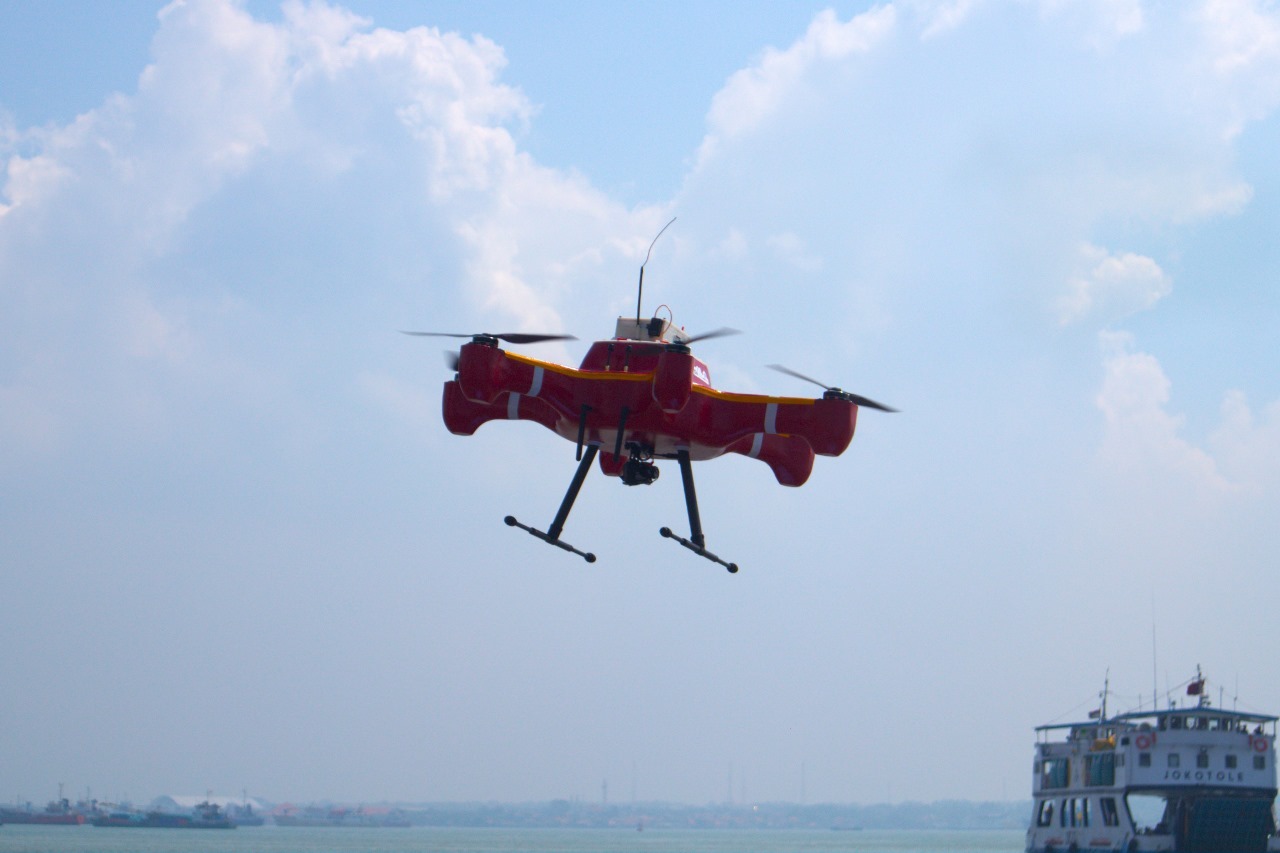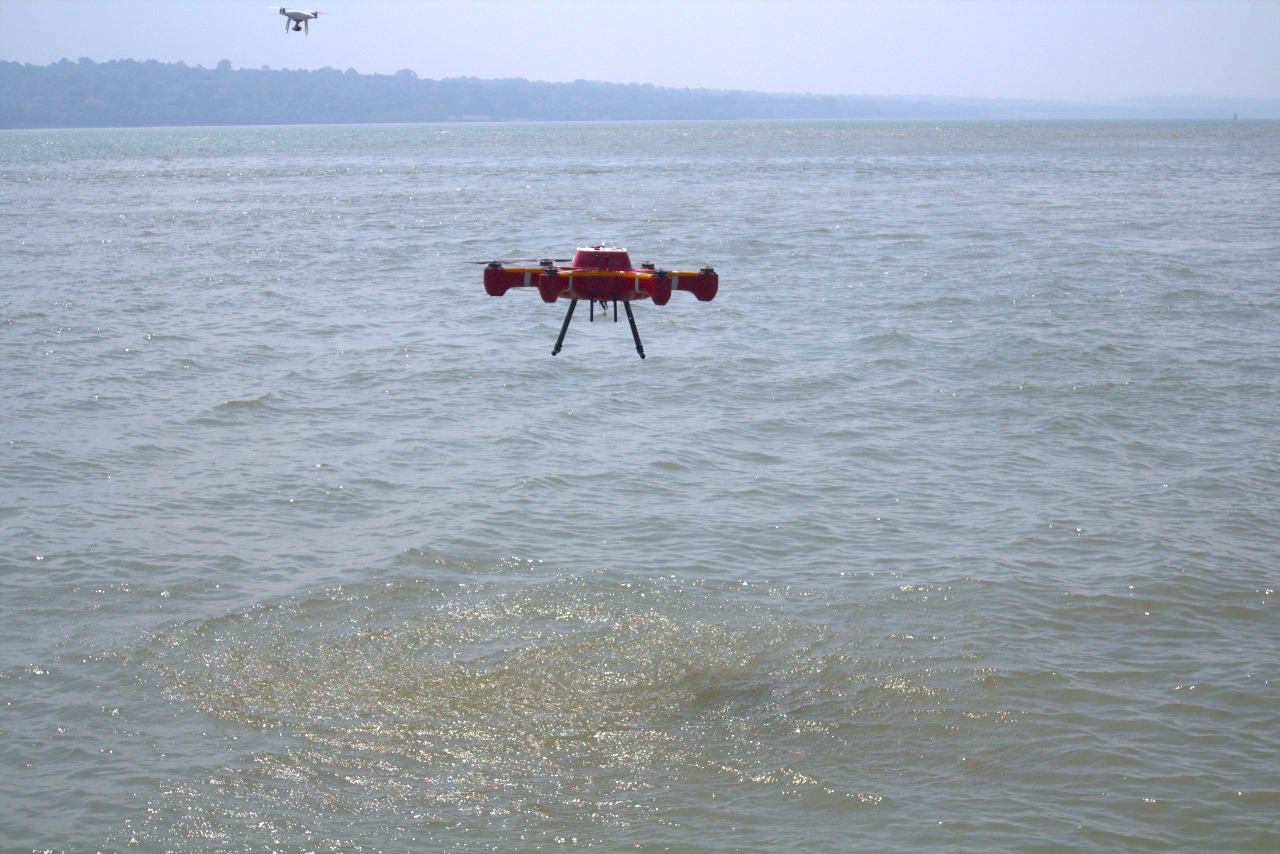First in Indonesia, ITS Launches Air Emission Detection Drone

A sniffing drone by ITS collaboration with BKI and Beehive Drones during a surveillance test over the sea at Tanjung Perak Port, Surabaya
ITS Campus, ITS News – Institut Teknologi Sepuluh Nopember (ITS) in collaboration with Beehive Drones and the Indonesian Bureau of Classification (BKI) created the Sniffing Drone, the first innovative tool in Indonesia capable of detecting greenhouse gas emissions in the air. The first of its kind in Indonesia and equipped with advanced features that can be accessed in real-time to improve its accuracy and functionality, the drone was officially launched at Tanjung Perak Port in Surabaya on Tuesday (28/5).
Kedaireka ITS Research Team Leader Ir Tri Achmadi PhD explained that the sniffing drone with the BVD-M16A series is a multipurpose Unmanned Aerial Vehicle (PUTA) that has the main function of detecting greenhouse gas emissions in the air. This innovative tool has been embedded with BVD-Sniffing sensors to detect seven types of air pollutants such as CO2, CO, NO2, NO, SO2, PM2.5, and PM10.
These pollutants can be detected and measured in real-time, through the approach sensors. This function can help BKI and Kesyahbandaran and Port Authority (KSOP) as users to carry out port functions and ship standardisation. The data can also be used to reduce air emissions in Indonesia.

One of the members of Beehive Drones preparing a sniffing drone for a trial at Tanjung Perak Port, Surabaya
According to Tri, this sniffing drone also functions as a surveillance tool. The BVD-M16A is equipped with a thermal camera and RGB camera to facilitate surveillance activities in water areas. In addition, the Light Detection And Ranging (LiDAR) radar allows this tool to measure the depth of an object and prevent the tool from other unwanted objects. “These features make the BVD-M16A drone effective for reaching difficult areas and monitoring,” said the ITS Maritime Innovation Centre Manager.
The sniffing drone equipped with a floater system is suitable for operation in water areas such as ports and beaches. With a range of up to 20 kilometres, the drone can also be used in open waters. Turbulent sea waves do not prevent the drone from taking off and landing on the sea surface. The materials used have been carefully considered, so the drone remains stable.

ITS sniffing drone undergoing a floater system test above sea level at Tanjung Perak Port, Surabaya.
Using an Internet of Things (IoT)-based dashboard, all information from drone sniffing can be accessed through the putaradar.id website in real-time. The dashboard contains various sources of information on the type and level of emissions, the type of ship, and the name of the port. “With this information, users can know the feasibility of a ship and can also be used as a reference to reduce greenhouse gas emissions,” explained the lecturer of the Marine Transportation Engineering Department.
The dashboard is also equipped with an emission threshold indicator per ship, allowing users to determine the feasibility of a ship. Features in the dashboard will be customised according to the type of user. For example, at KSOP, users can see daily emission check data, ship-to-ship emission result data, evidence of emission smell results, and data owned by pilots in the field. All information can be accessed in real-time on the website.
After three tests, namely sniffing, surveillance, and floater system, the sniffing drone seems to be able to complete everything smoothly. This provides evidence that the innovative tool is suitable for commercialisation and productive use in the community.

Drone sniffing during a floater system trial at Tanjung Perak Port, Surabaya
The sniffing drone works by sucking in exhaust emissions from ships or dock areas, then capturing them in the BVD-Sniffing emission sensor. The sensor detects each particle that has been sniffed using its built-in pollutant sensor. The data from the sensor is processed by software and uploaded to the cloud, so that the results can be seen through the dashboard.
Head of Sea Transport and Port Traffic Division of KSOP Nanang Afandi SE MM hopes that this tool can help KSOP in detecting pollutant emissions from ships in Tanjung Perak Port, Surabaya. He also hopes that this tool can be used more widely to support Indonesia’s target of achieving zero emissions by 2060. “The use of this technology is an important step in national efforts to reduce pollution and preserve the environment,” he said. (ITS Public Relations)
Reporter: Muhammad Rizky Putra Wahyuana
Translator: I Gusti Agung Jaya Hiswara
Related News
-
Facilitating Creativity of Students, ITS Information Systems Department Presents CCWS
ITS Department of Information Systems students conduct a discussion in one of the available spaces in the ITS Digital
May 28, 2024 18:05 -
ITS Explores Electrification Cooperation with PT Vale Indonesia
ITS Campus, ITS News — Following up on the Memorandum of Understanding (MoU) with PT Vale Indonesia, Institut Teknologi
May 28, 2024 18:05 -
ITS Reaches Top 7 BRIN Collaborators with 309 Scientific Publications
ITS Campus, ITS News — Institut Teknologi Sepuluh Nopember (ITS) continues demonstrating its commitment to strengthening collaboration in research
May 28, 2024 18:05 -
The Only One from Indonesia, ITS Student Becomes Erasmus+ Scholarship Awardee
ITS Campus, ITS News — Civitas academica of Institut Teknologi Sepuluh Nopember (ITS) has once again contributed to making
May 28, 2024 18:05
